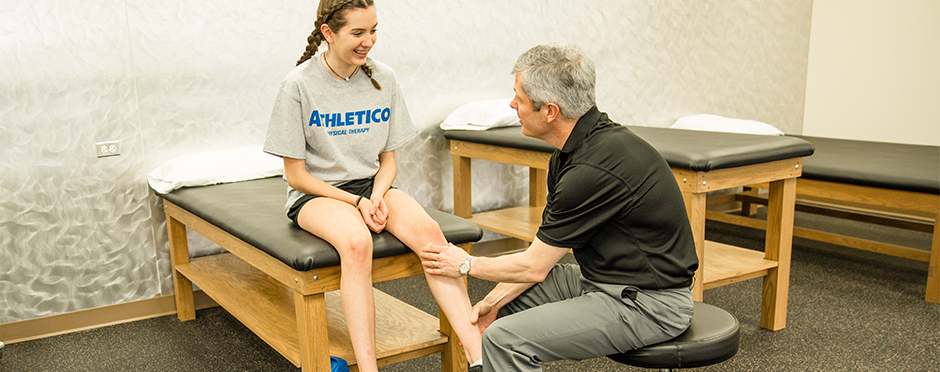
Who is at Risk for Jumper’s Knee?
Leave a CommentSports that involve high levels of running and jumping can leave athletes at increased risk for certain injuries. Basketball is an example of a sport that can predispose athletes to knee pain. Several studies have shown that the knee is the most common site of injury reported in adolescent basketball players, both male and female.1,2
Oftentimes knee pain occurs in the patellar tendon, which is located just below the kneecap. The patellar tendon is at risk for tendinopathy due to high repetition and overuse that can occur during sports with a lot of running and jumping. This type of injury is more commonly known as “jumper’s knee.”
Jumper’s knee is categorized as an overuse injury. This means there is no single traumatic event or injury but more of a gradual increase in pain below the knee. Adolescent athletes may be at an increased risk for tendinopathy development due to their rapid increase in muscle strength, while the tendon stiffness and cross sectional area are not similarly matured.2
Who is at risk of jumper’s knee?
The risk of jumper’s knee is greater with those athletes that participate in sports with a lot of jumping and running – like volleyball or basketball. There are a couple of other factors that may increase the risk of this condition:
- Male athletes may be at a greater risk for jumper’s knee2
- There is a greater incidence of patellar tendon pain in athletes who train on concrete compared to wood surfaces3
- Sport specialization is a risk factor for patellar tendinopathy compared to multi-sport athletes3
- Decreased quadriceps flexibility
- Decreased hamstring flexibility3
- Training more than 12 hours/week4
Ways to decrease jumper’s knee symptoms
- Stretch your quadriceps muscles
- Stretch your hamstring muscles
- Be aware of training surface – aim for surfaces with some shock absorbency as opposed to concrete
- Vary your sport activity – try not to only participate in sports with heavy running and jumping
- Cycling and swimming are good alternatives
- Do not over train
- Monitor the amount of hours practiced and competed each week
- Be aware of your body and any signs of inflammation surrounding the knee
- Rest if any inflammation is noted
What else could knee pain be a symptom of?
Not all knee pain is jumper’s knee. There are several other knee conditions that affect adolescent athletes more than adult athletes, including:
Osgood-Schlatter Disease: Pain is located over the tibial tuberosity (the bump below the kneecap) and there can be swelling and tenderness at this area. Osgood-Schlatter disease affects both boys and girls generally between ages 9 and 16. Many children with this condition have experienced a recent growth spurt and may be involved with sports with a lot of running and jumping.
Sinding Larsen Johansson Syndrome: This condition is similar to Osgood-Schlatter disease, except the painful location is at the lower end of the kneecap. Swelling can be present in this area as well as tenderness. Again, this condition is more often seen in adolescent athletes after a growth spurt. Running and jumping sports can aggravate this condition.
As always, if you are concerned about knee pain, make sure to take action before the injury gets worst. Contact your nearest Athletico and request a complimentary injury screening.
Schedule a Complimentary Injury Screen
The Athletico blog is an educational resource written by Athletico employees. Athletico bloggers are licensed professionals who abide by the code of ethics outlined by their respective professional associations. The content published in blog posts represents the opinion of the individual author based on their expertise and experience. The content provided in this blog is for informational purposes only, does not constitute medical advice and should not be relied on for making personal health decisions.
References:
1. Ito E, Iwamoto J, Azuma K, Matsumoto H. Sex-specific differences in injury types among basketball players. Open Access Journal of Sports Medicine. 2015;6:1-6.
2. Leppänen M, Pasanen K, Kujala UM, Parkkari J. Overuse injuries in youth basketball and floorball. Open Access Journal of Sports Medicine. 2015;6:173-179.
3. Reinking MF. CURRENT CONCEPTS IN THE TREATMENT OF PATELLAR TENDINOPATHY. International Journal of Sports Physical Therapy. 2016;11(6):854-866.
4. Tiemessen IJ, Kuijer PPF, Hulshof CT, Frings-Dresen MH. Risk factors for developing jumper’s knee in sport and occupation: a review. BMC Research Notes. 2009;2:127. doi:10.1186/1756-0500-2-127.
